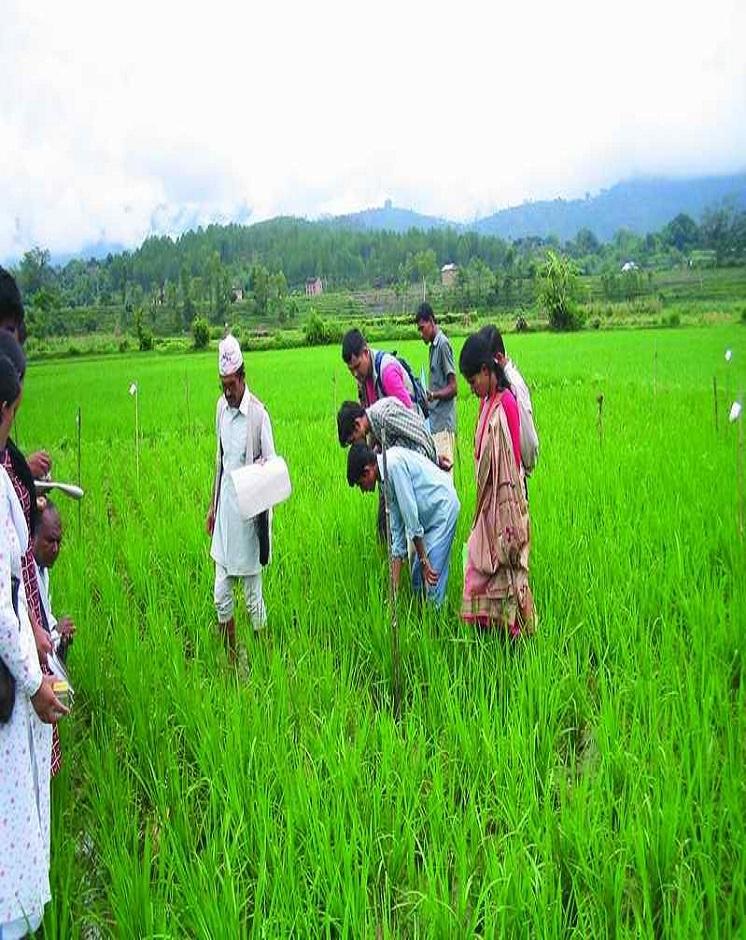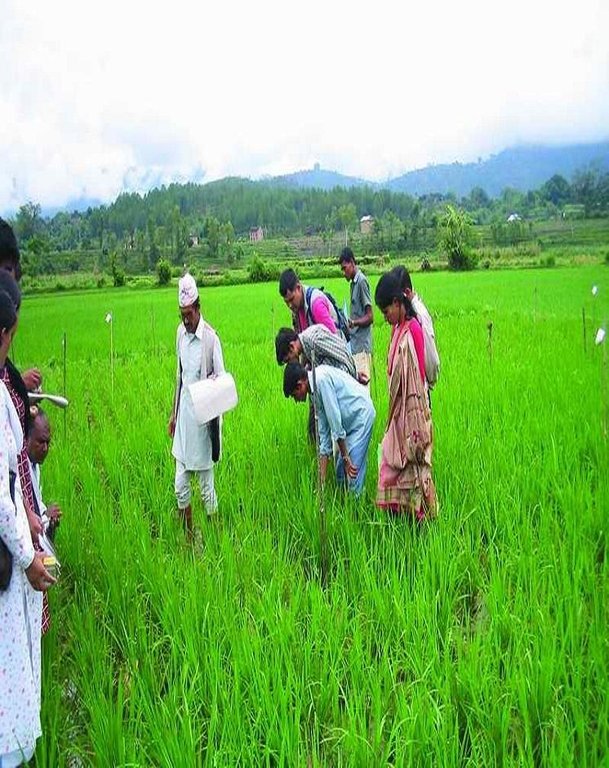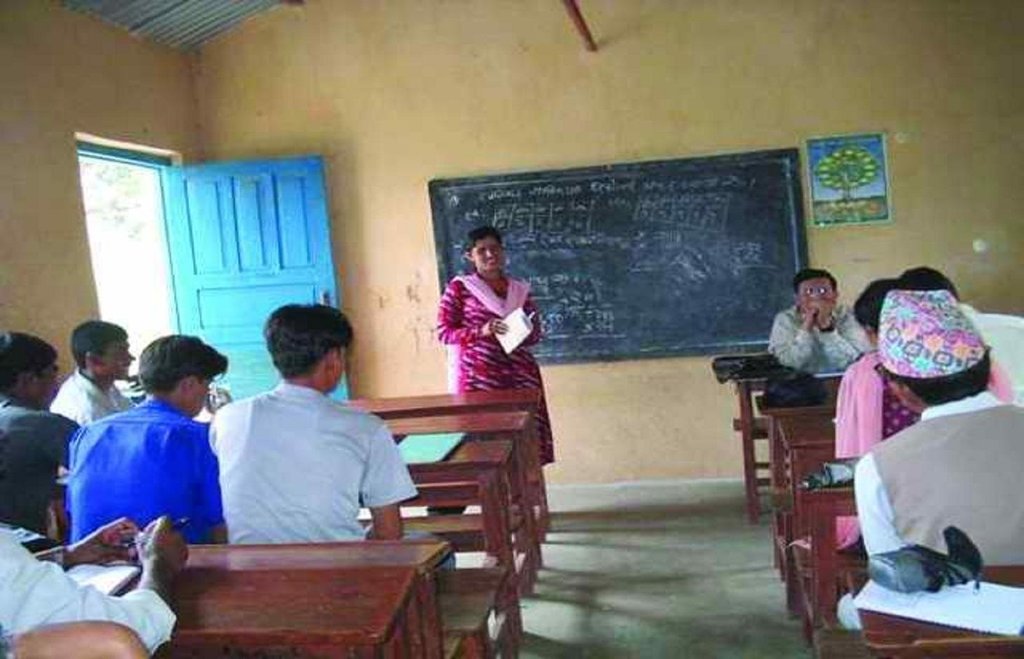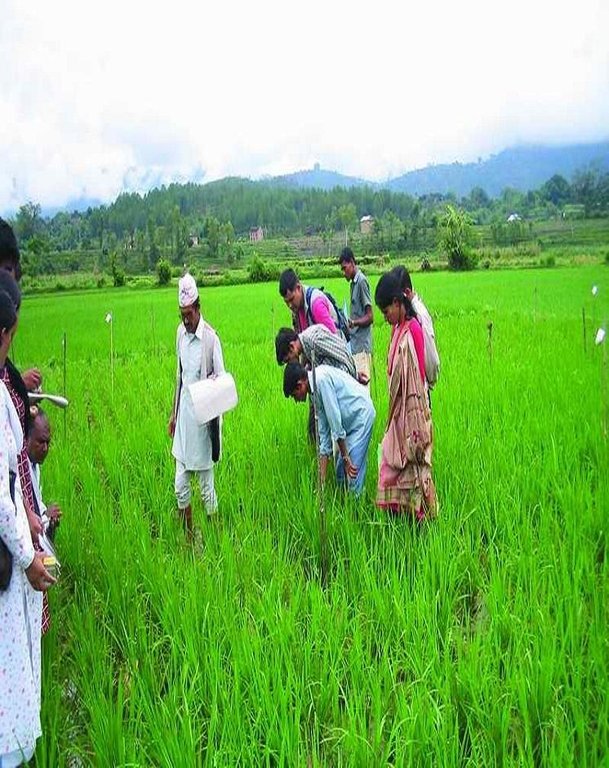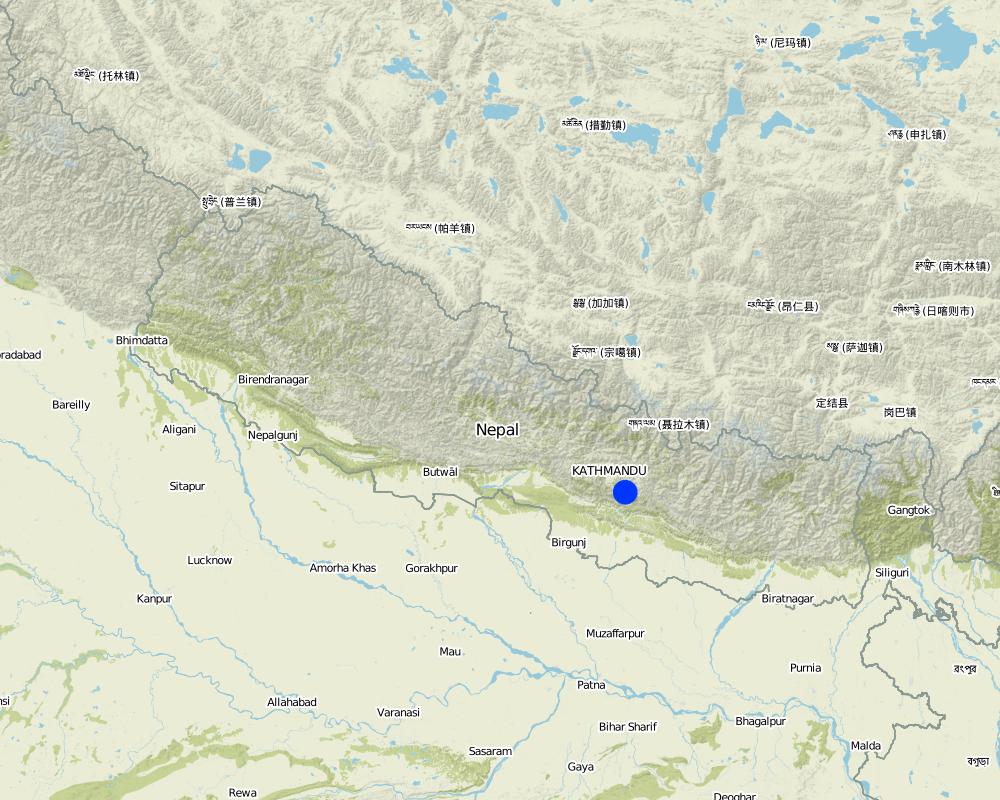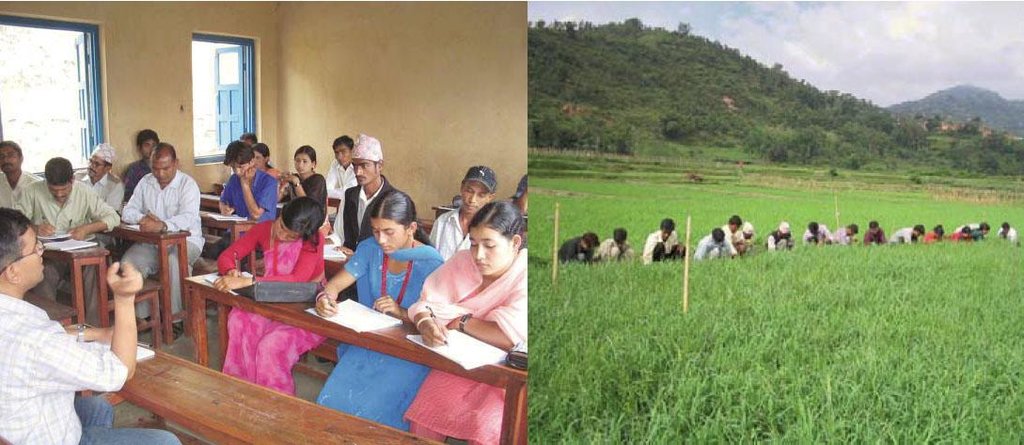Evaluation of the System of Rice Intensification through participatory research and development [Nepal]
- Creation:
- Update:
- Compiler: Madhav Dhakal
- Editor: –
- Reviewer: Fabian Ottiger
Sahabhagitamulak anusandhan ra bikas dwara dhan uttpadan bridhhi garne tarika ko mulyankan (Nepali)
approaches_2550 - Nepal
View sections
Expand all Collapse all1. General information
1.2 Contact details of resource persons and institutions involved in the assessment and documentation of the Approach
SLM specialist:
Name of the institution(s) which facilitated the documentation/ evaluation of the Approach (if relevant)
CDE Centre for Development and Environment (CDE Centre for Development and Environment) - SwitzerlandName of the institution(s) which facilitated the documentation/ evaluation of the Approach (if relevant)
ICIMOD International Centre for Integrated Mountain Development (ICIMOD) - Nepal1.3 Conditions regarding the use of data documented through WOCAT
The compiler and key resource person(s) accept the conditions regarding the use of data documented through WOCAT:
Yes
1.4 Reference(s) to Questionnaire(s) on SLM Technologies
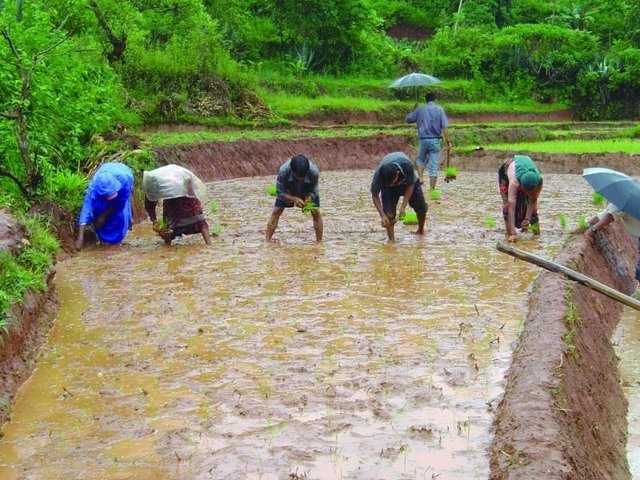
System of Rice Intensification [Nepal]
A method for increasing the productivity of rice by changing the management of plants, soil, water, and nutrients.
- Compiler: Madhav Dhakal
2. Description of the SLM Approach
2.1 Short description of the Approach
Conducting participatory action research with farmers and district level line agencies for demonstrating, disseminating and scaling up SRI
2.2 Detailed description of the Approach
Detailed description of the Approach:
Aims / objectives: PARDYP pilot tested SRI in the Spice Crop Development Centre (SCDC) at Tamaghat, Kavrepalanchok in 2002. The positive results led the technique to be tried out in 25 farmer’s fields in 2004 to evaluate whether SRI was technically feasible in the Himalayan middle mountains. Based on farmers’ interests and to promote SRI systematically, PARDYP organised interaction programmes between farmers who had and had not used SRI, village level group discussions, farmer-to-farmer visits and farmer-led on-site monitoring and evaluation in 2002, 2003 and 2004.
Methods: In 2005, the emphasis shifted to carrying out research with groups of farmers in a more systematic way and participatory rural appraisal methods and tools were used. The approach was called the SRI farmer field school (FFS) approach. Lead farmers (13 male and 6 female) were trained as SRI trainers and then facilitated village level farmer field schools for testing and promoting SRI. In 2005, SRI farmer field schools were run in 15 villages for about 100 farmers. Each school carried out hands-on training sessions to help farmers understand (1) the basic concepts of SRI and its practices, (2) methods for comparing traditional practices with SRI, and (3) how to observe, analyse and present findings more systematically. Monitoring and evaluation gathered both men’s and women’s perceptions. This also helped establish an informal farmer-learning network in the watershed. Village level discussions, farmer visits, and interaction with staff from the district agriculture offices continued. At the end of the on-farm experiments, a district level farmer’s day was organised to share the experiences gained.
Other important information: To promote wider understanding of the action research and encourage farmers to continue developing and adapting SRI, the project disseminated information about SRI through information, education and communication (IEC) materials aimed at community-level users, and a multi-media package on a CD ROM for the global audience and Nepali policy-makers and administrators. A national exchange workshop was held to share experiences from across the country on the use of SRI.
2.3 Photos of the Approach
2.5 Country/ region/ locations where the Approach has been applied
Country:
Nepal
Further specification of location:
Kavrepalanchowk/ Jhikhu Khola watershed
Map
×2.6 Dates of initiation and termination of the Approach
Year of termination (if Approach is no longer applied):
2005
2.7 Type of Approach
- project/ programme based
2.8 Main aims/ objectives of the Approach
The Approach focused mainly on SLM with other activities (Rice cultivation, watersaving, agronomic innovation)
- To demonstrate and evaluate the innovative SRI technique under local conditions with land users' participation. - To inform farmers about the basic concepts, associated principles, and technical know-how related to SRI. - To share knowledge gained on SRI with a wider audience. - To scale up the innovation across larger areas
The SLM Approach addressed the following problems: - Lack of systematic on-farm research for developing a technology that takes into account farmers' needs. - Weak institutional collaboration for technology development, dissemination and scaling up. - Poor soil fertility, limited crop production, and poor irrigation facilities
2.9 Conditions enabling or hindering implementation of the Technology/ Technologies applied under the Approach
availability/ access to financial resources and services
- hindering
Government incentives lacking
Treatment through the SLM Approach: The innovation is cost effective and doesn't need additional inputs
institutional setting
- hindering
Lack of cordination among land users
Treatment through the SLM Approach: Informal SRI farmers network established with trained human resources.
legal framework (land tenure, land and water use rights)
- enabling
The existing land ownership, land use rights / water rights greatly helped the approach implementation: The individual land use rights helped in implementing the technology as there were no conflicts among land users.
knowledge about SLM, access to technical support
- hindering
It is not a priority area of line agencies
Treatment through the SLM Approach: Sharing of technical know how with concerned stakeholders
other
- hindering
lack of awareness
Treatment through the SLM Approach: Trainings, group discussions , field visits
3. Participation and roles of stakeholders involved
3.1 Stakeholders involved in the Approach and their roles
- local land users/ local communities
Spices Crop Development Centre and farmer groups
Women are generally busy with in-house work. There was only 30 % women participation. Initially SRI was demonstrated onindividual farmers' field. Working land users were mainly men (about 30 percent were women), villlage level groups were formed.
- NGO
PARDYP project
- national government (planners, decision-makers)
- international organization
If several stakeholders were involved, indicate lead agency:
Concept and orientation - national specialists and implementation of the approach jointly with land users.
3.2 Involvement of local land users/ local communities in the different phases of the Approach
| Involvement of local land users/ local communities | Specify who was involved and describe activities | |
|---|---|---|
| initiation/ motivation | passive | public meetings; First year's on-station demonstration with results shared at public meetings |
| planning | interactive | public meetings; Public meetings organised in different villages; villagers selected lead farmers for the training, and orientation meeting held to plan activities |
| implementation | interactive | responsibility for major steps; Farmers themselves implemented the activities; the project facilitated the research and arranged logistics |
| monitoring/ evaluation | interactive | Measurements, observations and reporting were carried out once a week. At the end of the project, results were evaluated through interviews using questionnaires. Public meeting organised to share results with district level stakeholders |
| Research | interactive | On-farm and on-station research conducted; information from research station collected by technicians; farmers themselves collected information from their fields |
3.3 Flow chart (if available)
Description:
left: Public meeting: an orientation meeting to plan and implement SRI activities. Right: Lead farmers in the demonstration field – an activity of a farmer field school.
Author:
Madhav Dhakal
3.4 Decision-making on the selection of SLM Technology/ Technologies
Specify who decided on the selection of the Technology/ Technologies to be implemented:
- mainly SLM specialists, following consultation with land users
Explain:
SRI is being tested in many countries in Asia and rest of the world with proven benefits. Project staff shared SRI principles and methods with the watershed-farmers, few of them came forward and tested it to observe the performance in the local condition.
Decisions on the method of implementing the SLM Technology were made by mainly by SLM specialists with consultation of land users. It was tested first at a research station to build confidence of project staff and surrounding villagers, and was then taken to interested farmers' fields
4. Technical support, capacity building, and knowledge management
4.1 Capacity building/ training
Was training provided to land users/ other stakeholders?
Yes
Specify who was trained:
- land users
- field staff/ advisers
Form of training:
- farmer-to-farmer
- demonstration areas
- public meetings
- courses
Subjects covered:
The principles associated with SRI, participatory research procedures, and farmers' concerns (men and women).
4.2 Advisory service
Do land users have access to an advisory service?
Yes
Specify whether advisory service is provided:
- on land users' fields
Describe/ comments:
Name of method used for advisory service: Farmer - to - Farmer Extension of SRI; Key elements: Use of local farmers as facilitators, Farmer - to - farmer visits, Public meetings , national workshop; 1) Advisory service was carried out through: projects own extension structure and agents; Extension staff: specifically hired project employees 2) Target groups for extension: land users; Activities: trainings, group discussions, farm visits
Advisory service is quite adequate to ensure the continuation of land conservation activities; Large number of farmers can now implement SRI with confidence, there are 15 local trainers who can train many farmers, which insures the continuation of SRI activities .
4.3 Institution strengthening (organizational development)
Have institutions been established or strengthened through the Approach?
- no
4.4 Monitoring and evaluation
Is monitoring and evaluation part of the Approach?
Yes
Comments:
bio-physical aspects were ad hoc monitored through observations; indicators: soil condition and irrigation facilities
technical aspects were regular monitored through measurements; indicators: number of tillers, tiller height, climatic conditions
socio-cultural aspects were ad hoc monitored by 0 through observations; indicators: preference for rice varieties
economic / production aspects were regular monitored through observations; indicators: grain and biomass production, cost of production
area treated aspects were ad hoc monitored through measurements; indicators: area of SRI cultivation
no. of land users involved aspects were ad hoc monitored through observations; indicators: frequency of farm visits and record keeping
management of Approach aspects were regular monitored through observations; indicators: training management by farmer field school management sub-committees
4.5 Research
Was research part of the Approach?
Yes
- Comparision between traditional and SRI methods
Give further details and indicate who did the research:
Participatory research at the farmer field schools was a key element of the approach. The schools compared the inputs and outputs of the traditional and SRI methods including the differences in grain and biomass production, the costs and benefits, and the advantages and disadvantages.
Research was carried out both on station and on-farm
5. Financing and external material support
5.1 Annual budget for the SLM component of the Approach
If precise annual budget is not known, indicate range:
- 2,000-10,000
Comments (e.g. main sources of funding/ major donors):
Approach costs were met by the following donors: international (SDC, IDRC, ICIMOD): 90.0%; other (Jhikhu Khola farmers): 10.0%
5.2 Financial/ material support provided to land users
Did land users receive financial/ material support for implementing the Technology/ Technologies?
Yes
5.3 Subsidies for specific inputs (including labour)
- agricultural
| Specify which inputs were subsidised | To which extent | Specify subsidies |
|---|---|---|
| seeds | on- station and on- farm demonstration sites only | |
| fertilizers | on- station and on- farm demonstration sites only | |
| Biocides | on- station and on- farm demonstration sites only | |
If labour by land users was a substantial input, was it:
- voluntary
Comments:
Farmers worked either as a trainee or as a volunteer.
5.4 Credit
Was credit provided under the Approach for SLM activities?
No
6. Impact analysis and concluding statements
6.1 Impacts of the Approach
Did the Approach help land users to implement and maintain SLM Technologies?
- No
- Yes, little
- Yes, moderately
- Yes, greatly
The approach has helped participating farmers to improve soil and water management. They started to apply the recommended dose of chemical fertiliser and improved farmyard manure. The frequency of irrigation was reduced and there were less cases of terrace-riser failure caused by stagnant water. The
Did other land users / projects adopt the Approach?
- No
- Yes, little
- Yes, moderately
- Yes, greatly
A similar approach was used to promote SRI by a few projects in the same district.
Did the Approach lead to improved livelihoods / human well-being?
- No
- Yes, little
- Yes, moderately
- Yes, greatly
Through better management of rice crop
6.2 Main motivation of land users to implement SLM
- increased production
Increased (nearly doubled) production
- increased profit(ability), improved cost-benefit-ratio
Increased production with same or little less cost input
- environmental consciousness
Improved land and water management
6.3 Sustainability of Approach activities
Can the land users sustain what has been implemented through the Approach (without external support)?
- yes
If yes, describe how:
About 35 local land users had adopted the SRI method and previous adopters were continuing to use SRI method. However, some more time may be required for its wider adoption.
6.4 Strengths/ advantages of the Approach
| Strengths/ advantages/ opportunities in the land user’s view |
|---|
| Through farmer-to-farmer fi eld visits, farmers had an opportunity to observe others' fi elds and see the performance of SRI in different locations and conditions. (How to sustain/ enhance this strength: Continue such visits as farmers learn much more from farm visits and from sharing experiences with other farmers.) |
| Strengths/ advantages/ opportunities in the compiler’s or other key resource person’s view |
|---|
| Lead farmers served as key resource persons in the village-level farmer field schools. Data from test plots were analyzed by farmers on a weekly basis. This was very effective for promoting the sustainability of SRI. (How to sustain/ enhance this strength: Encourage district level agriculture offi ces to use the skills of lead farmers as resource persons to expand SRI in their districts.) |
| Action research was conducted through farmer field schools and lead farmers were trained in training of trainers programmes. These served as platforms for farmers to share their immediate concerns. Besides analysing and presenting, farmers' skills were also developed. (How to sustain/ enhance this strength: Implement the farmers fi eld school approach during technology implementation to build confi dence of land users and empower them in soil and water conservation.) |
| Participatory methods and tools were applied repeatedly. Farmer visits and village level group discussions were very effective for evaluating SRI. (How to sustain/ enhance this strength: Use participatory tools and methods widely during the technology implementing period) |
| Action research was conducted with farmer groups and individual households. The group approach was more systematic and helped to build confidence of land users in the technology (How to sustain/ enhance this strength: It should be maintained and continued on a regular basis to strengthen land users' involvement) |
6.5 Weaknesses/ disadvantages of the Approach and ways of overcoming them
| Weaknesses/ disadvantages/ risks in the land user’s view | How can they be overcome? |
|---|---|
| A long dry spell meant that the SRI observation plot could not be established near to the lead farmers' fi eld school site, and only 15 facilitators were able to establish observation plots in their villages. | This was due to natural causes (late arrival of monsoon), it can be improved easily if monsoon arrives on time. |
| Weaknesses/ disadvantages/ risks in the compiler’s or other key resource person’s view | How can they be overcome? |
|---|---|
| Agro-ecosystem analysis, as used at the farmer fi eld schools, became a time-consuming process as participants had to spend much time in preparing presentations. | Pre-planning and pre-preparation of presentation format should reduce the time length |
| Women's participation in the village level workshops was poor (2% at one location and 5% at another) | Encourage women to participate, and adapt programmes to suit their interests. |
| Due to time limits, not all SRI adopters' opinions and experiences could be covered during interaction workshops. The scattered farmer field schools (distance-wise) and the diffi cult political situation meant that exchange visits could not be organised for all schools. | Allocate enough time for such programmes |
7. References and links
7.1 Methods/ sources of information
- field visits, field surveys
- interviews with land users
7.2 References to available publications
Title, author, year, ISBN:
Dhakal, M.P. (2005) Farmers' Evaluation of System of Rice Intensifi cation in Middle Mountains of Nepal.Cornell International Institute for Food, Agriculture, and Development (CIIFAD)ICIMOD (2007) Good Practices in Watershed Management, Lessons Learned in the Mid Hills of Nepal. KathmanduIRRI - International Rice Research Institute.
Available from where? Costs?
ICIMOD, SRI.URL: http://ciifad.cornell.edu/sri/countries/nepal/index.htmlICIMODwww.irri.org.
Title, author, year, ISBN:
ICIMOD (2007) Good Practices in Watershed Management, Lessons Learned in the Mid Hills of Nepal. Kathmandu
Available from where? Costs?
ICIMOD
Title, author, year, ISBN:
IRRI - International Rice Research Institute.
Available from where? Costs?
www.irri.org.
Links and modules
Expand all Collapse allLinks

System of Rice Intensification [Nepal]
A method for increasing the productivity of rice by changing the management of plants, soil, water, and nutrients.
- Compiler: Madhav Dhakal
Modules
No modules


